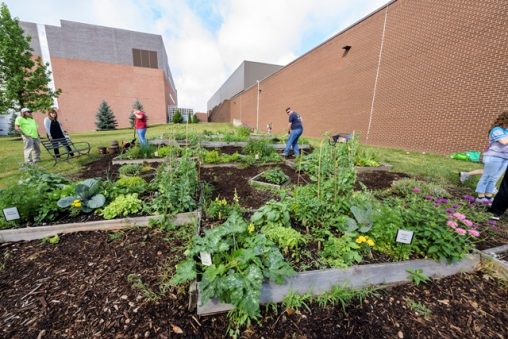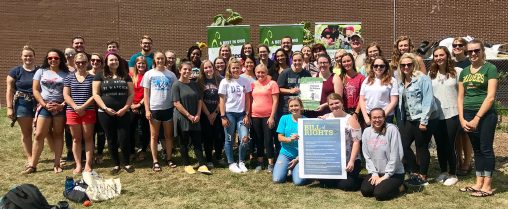
The Wright State teacher education program received a Best in Ohio Connect to Nature Site Award from the Miami Valley Leave No Child Inside Collaborative for connecting people on campus to nature and supporting local schools to create outdoor learning spaces.
The Wright State University College of Education and Human Services (CEHS) was honored for preparing teachers to get P–12 students outside while also supporting local schools with efforts to create outdoor learning spaces.
CEHS received a Best in Ohio Connect to Nature Site Award from the Miami Valley Leave No Child Inside Collaborative, Five Rivers MetroParks, the Miami County Park District, Centerville–Washington Park District and Dayton Children’s Hospital. The Miami Valley Leave No Child Inside Collaborative, a chapter of the Ohio Leave No Child Inside initiative, encourages outdoor exploration while giving people opportunities to develop the skills to become stewards of community green spaces.
“To be recognized for connecting people on our campus to nature and also helping to grow that across local schools who want to partner with us is exciting,” said Michelle Fleming, associate professor of STEM education and director of the Elementary Education Program in the College of Education and Human Services.
Douglas Horvath, outdoor education coordinator for Five Rivers MetroParks and chair of Miami Valley Leave No Child Inside Collaborative, said the organization was proud to recognize Wright State as the first university to receive the local Connect to Nature Award.
“These students and leaders really understand the importance of allowing youth to experience and interact with the gardens and nature to foster their learning experience,” Horvath said. “We know working with students outside helps them perform higher academically, lowers their stress and teaches them lifelong skills.”
Teacher candidates in Fleming’s early/elementary, middle and high school science methods courses spend time in nature planning and developing lesson plans that they can implement in local schools. The students also explore other outdoor features around the Dayton Campus, including the Wright State woods, Garden for the Senses and the Wright State garden.
The Wright State garden, which features 12 raised beds near the Student Union, provides a living laboratory for training, innovation and learning. The garden has supported the professional development of both preservice teacher candidates at Wright State and inservice teachers across several schools and districts over the past three years. It also promotes health, problem solving and creativity.
Growing produce in the garden beds is a collaborative effort between Fleming’s teacher candidates and biology students of Lisa Kenyon, associate professor of biological sciences.

The Wright State garden provides a living laboratory for training, innovation and learning for teacher education and biology students.
Getting teacher candidates outside not only helps them develop unique lessons for their students but also can help them with their mental and physical well-being and social-emotional learning.
“The garden is a space for all of us to connect nature, health and science education,” Fleming said. “Good teachers have to be happy and healthy. We focus on developing the whole teacher.”
While gardening in schools is not a new learning method, Fleming said, preparing teachers to create opportunities for their students to learn outside is unique to Wright State University.
Teacher candidates design and implement meaningful science lessons in local schools, often utilizing these school learning gardens. Lessons cover such topics as how do plants grow, how can the biodiversity change, how do we engage in the natural world.
Learning in a natural environment can spark curiosity and joy in both students and teachers, Fleming said.
“Natural science is happening outside,” she said. “They can go outside, experience together, and talk about common ideas through these common experiences.”
One thing Fleming shares with partnering schools is that gardens and green spaces can come in a variety of shapes and sizes.
“It doesn’t have be a big space,” she said. “There’s a lot you can learn in a field of grass. Just getting outside and realizing you are part of a bigger world.”
Fleming estimates the program works with more than 1,000 schoolchildren a semester. Teacher candidates divide into several classrooms, across multiple schools and grade levels.
Fleming’s collaborators include Kenyon; Colleen Saxen, adjunct faculty in teacher education; Nimisha Patel, chair of teacher education; Tracey Kramer, director of the Office of Partnerships and Field Experience; and Amy Elston, faculty in teacher education. Fleming also partners with Five Rivers MetroParks, which has supplied tools, compost and seeds. Nadja Turek, an engineer at Woolpert, helps partnering schools design, build and redesign their learning gardens. Turek works with Fleming to set up Green Apple Day of Service events and connects with the local chapter of the United States Green Building Council. Contributions to support learning gardens have also come from environmental scientists at Speedway Corporation.

Teacher candidates design and implement meaningful science lessons in local schools, often utilizing these school learning gardens.
Fleming was inspired to start gardening in schools after her family participated in a family garden community project. While her two young children did not like to eat produce from the grocery store, they would eat anything grown in the garden.
“They hated lettuce from the store; they hated radishes from the store,” she said. “But if they grew it and they picked it, they ate it.”
Fleming says both children and adults are likely to care more about an outdoor space or learning garden if they work in it and have multiple opportunities to enjoy it.
“There’s a shift I feel when I am around the teacher candidates and together we are all working in a garden and we are all recognizing a greater biodiversity in this space and ‘wow, we feel so much better in this space,'” Fleming said. “The culture of the class shifts and the climate changes.”

 Bags, boards and bonding
Bags, boards and bonding  More than 1,000 students to graduate at Wright State’s fall commencement ceremonies
More than 1,000 students to graduate at Wright State’s fall commencement ceremonies  Wright State’s Take Flight Program helps students soar high
Wright State’s Take Flight Program helps students soar high  Wright State Police Department delivers major donation to Raider Food Pantry
Wright State Police Department delivers major donation to Raider Food Pantry  Wright State engineering and computer science students earn prestigious federal SMART Scholarships
Wright State engineering and computer science students earn prestigious federal SMART Scholarships 